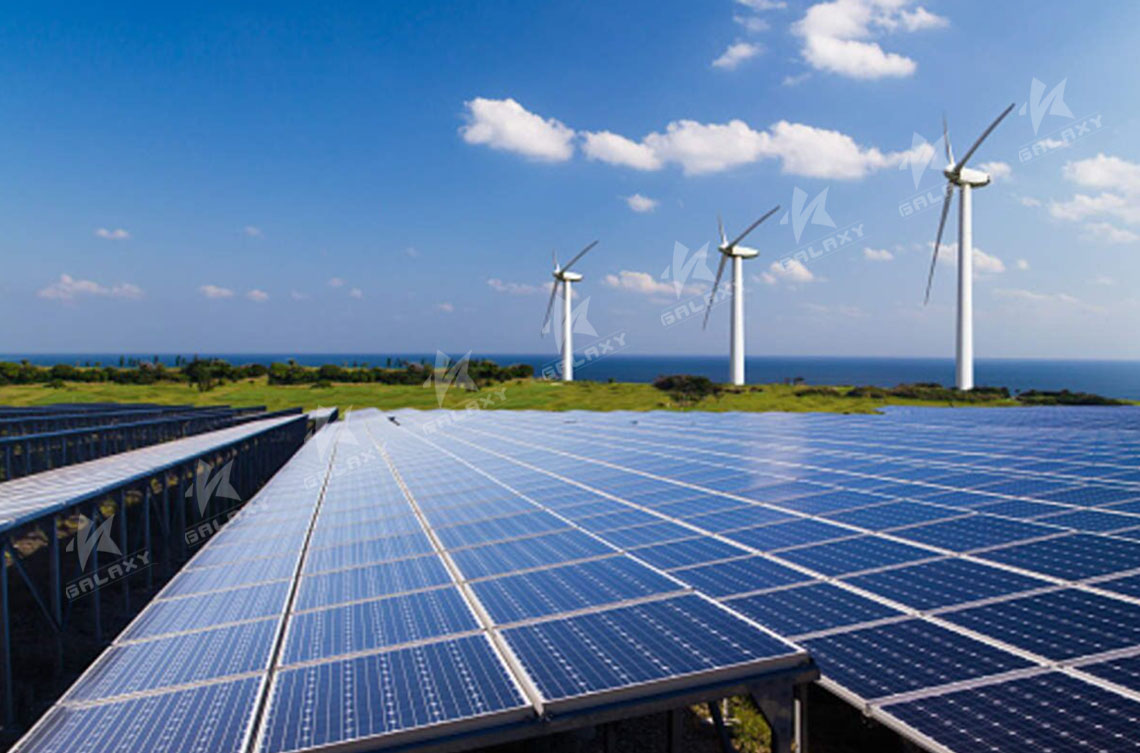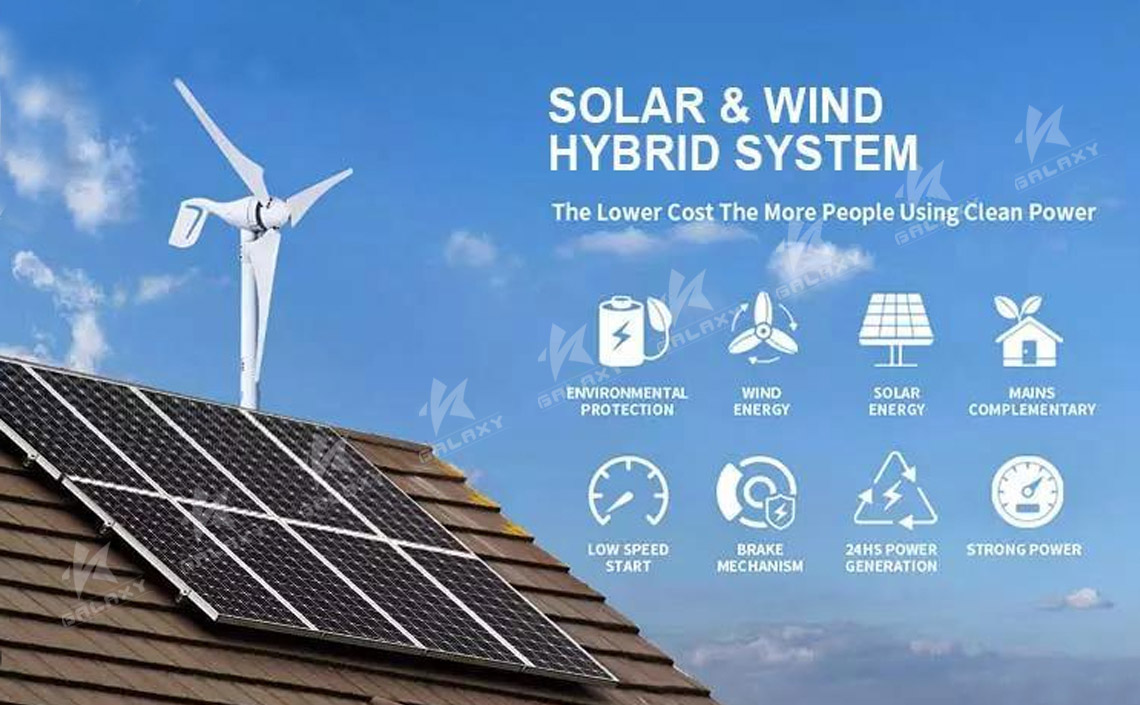BLOG
Overview of Wind-Solar Hybrid System (I)
Wind-solar hybrid system is a set of power generation application system. The system uses solar cell array and wind generator (converts alternating current into direct current) to store the electric energy emitted into the battery bank. When the user needs electricity, the inverter converts the direct current stored in the battery bank into alternating current and sends it to the user's load through the transmission line. Is wind generator and solar cell array two kinds of power generation equipment together to generate electricity, constitute distributed power supply.
The hybrid system can also provide direct current for use by corresponding DC loads.

Introduction
Solar power generation is easy to arrange and maintain, and has a wide range of applications. The total installed capacity of the world has begun to catch up with the traditional wind power generation, and in Germany it even approaches 5%-8% of the total power generation of the country. The ensuing problem makes us unexpected. How to solve this problem is a big puzzle in the energy world.
Wind power generation has been on the stage of history since the end of the 19th century. In more than one hundred years of development, wind power generation has always been the sole sole contender in the field of new energy. Due to its relatively low cost, it has become the first choice for the development of new energy in various countries. It's just another puzzle for us.
The new vertical axis wind turbine (H type) breaks through the shortcomings of the traditional horizontal axis wind turbine, such as high wind speed, loud noise, poor wind resistance and wind direction effect. It adopts a completely different design theory and adopts the new structure and materials to achieve the performance of breeze start-up, no noise, resistance to typhoon of more than 12, and not affected by the wind direction. Can be widely used in villas, multi-storey and high-rise buildings, street lamps and other small and medium-sized applications. The wind-solar hybrid power generation system based on it has the advantages of stable power output, high economy and small impact on the environment, and also solves the impact of the development of solar energy on the grid.

1. Wind Turbine
A wind turbine is a device that converts the mechanical energy of a wind turbine into electrical energy. Wind turbines are divided into DC generators and AC generators.
1) DC Generator
Electrically excited DC generator. This kind of generator is divided into self-excited, self-excited and compound excited three forms, small DC power generation system and battery matching use, device capacity is generally less than 1000 w.
Permanent magnet DC generator. This kind of generator has simple structure compared with the electric excitation type DC generator, its output voltage varies with the wind speed, need to add a battery and control system between the generator and the load, by adjusting the duty ratio of the control system to adjust the output voltage. Due to the complex structure and expensive price of DC generator, and DC generator with commutator and commutator, once failure, maintenance is very troublesome, so this kind of wind turbine is rarely used in practical applications.
2) Alternator.
Alternator: synchronous generator and asynchronous generator.
Synchronous generators operate at synchronous speed, which is determined by the number of poles and frequency of the synchronous generator, while asynchronous generators operate at slightly higher speeds than the synchronous generator. The main brushless claw pole self-excited generator, rectifier self-excited alternator, induction generator and permanent magnet generator.
Three phase permanent magnet synchronous generator is mainly used in small wind power generation system. The three phase permanent magnet synchronous generator is generally small in size, high in efficiency, and cheap. The stator structure of permanent magnet synchronous generator is the same as that of general synchronous motor, and the rotor adopts permanent magnet structure. Because there is no excitation winding, no excitation power is consumed, so it has higher efficiency. In addition, because the permanent magnet synchronous generator eliminates the reversing device and brush, high reliability, stator iron and mechanical loss is relatively small, long service life.
2. Principle of Solar Photovoltaic Cells
Photovoltaic cells are devices that directly convert solar energy into electric energy. The working principle is as following: when sunlight radiates to the surface of photovoltaic cells, photons will impact the valence electrons inside the photovoltaic cells. When the energy of the valence electrons is greater than the band-gap width eg, the valence electrons will break out of the constraint of covalent bonds and be excited from the valence band to the conduction band, generating a large number of non-equilibrium electron-hole pairs. After free collision, the excited electrons and holes are recombined to achieve equilibrium in the photovoltaic cell semiconductor.
3. Battery
As the energy storage device of wind-solar hybrid power generation system, the battery plays a very important role in the whole power generation system.
First of all, because the natural wind and light are unstable, in the case of excess wind and light, storage load power supply excess energy, in the case of poor wind and light, energy storage device battery can be used as the load power supply;
Secondly, the battery has the function of filtering, can make the power generation system more stable output power to the load;
In addition, wind power generation and photovoltaic power generation are easily affected by climate and environment, and the amount of electricity produced is different at different times and also varies greatly. As the "hub" between them, the battery can be well connected, and can integrate solar and wind energy, to achieve a hybrid effect between the two.
Commonly used batteries are mainly lead-acid batteries, alkaline nickel batteries and cadmium nickel batteries. With the continuous development of electric energy storage technology, there are more and more new energy storage methods, such as superconducting energy storage, super capacitor energy storage, fuel cells and so on. Because of its cheap cost, simple use, convenient maintenance, rich raw materials, and continuous progress and improvement in technology, lead-acid batteries have been widely used in small wind power generation and photovoltaic power generation.